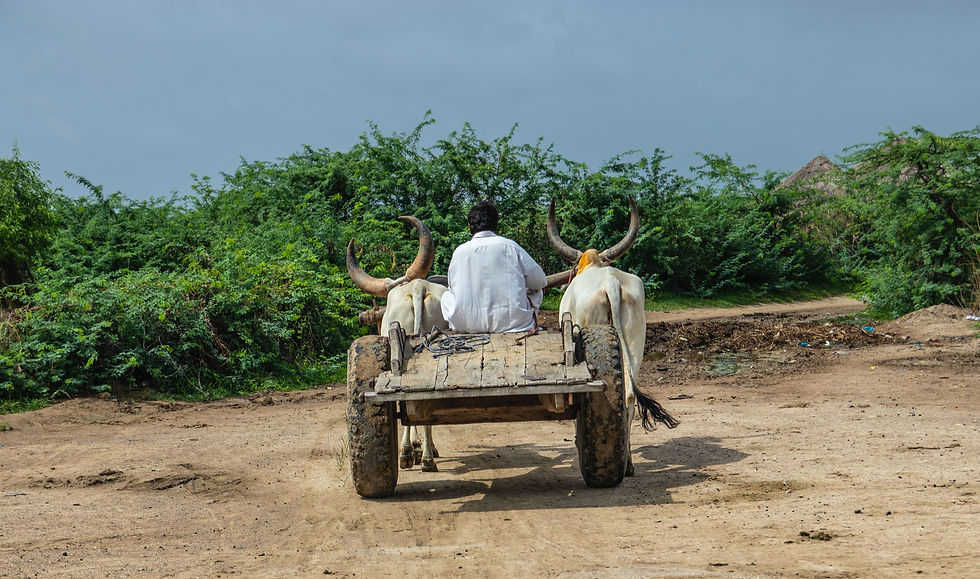Why The Bullock Cart Still Matters In Sri Lanka’s Cultural Memory
- Kiran Dias

- Oct 15
- 3 min read

There was a time when the sound of wooden wheels rolling down a dirt road was as common in Sri Lanka as birdsong at dawn. The bullock cart, with its slow grace and practical charm, once carried the nation forward - literally. It was the transport of choice in village life, used to haul goods, carry people, and weave through winding inland paths long before asphalt and engines took over.
Today, the bullock cart is less of a necessity and more of a nostalgic emblem, preserved in pockets of the country like Sigiriya, where cart rides have evolved into a tourist experience - something between a heritage walk and a countryside safari.
But for those who remember the era when these carts were everywhere, their quiet disappearance tells a deeper story about modernisation, cultural memory, and the fragile line between progress and preservation.
More Than Just a Ride
Historically, bullock carts were more than just transport. They were status symbols, livelihood tools, and social markers. Two distinct types stood out:
Thirikikka: The single-seater cart used mainly by wealthier individuals, often ornately built.
Bakki Karaththaya: The more spacious version, named after its bakki-like rear basin, used for transporting passengers - often village headmen or elders - with a bit more comfort and flair.
These carts weren’t just functional - they were often crafted with pride, using timbers like Sooriya Mara, and adorned with village-specific motifs. Their construction and use reflected the rhythm of rural life: slow, deliberate, communal.

A Tradition Under Pressure
While bullock carts still roll in some areas, especially in tourism hotspots, the broader industry has faded. Cart makers struggle to find raw materials and skilled blacksmiths, and fewer young people are taking up the craft. In places like Galevela, artisans like Chandrarathna, who learned cart making from his father, now find themselves grappling with a vanishing trade.
“It is difficult to source the right timber, and even harder to find blacksmiths to make parts,” he says. And without regular demand, keeping the craft alive becomes increasingly impractical.
The irony? Tourist interest is still strong. Visitors to Sigiriya and Polonnaruwa eagerly sign up for cart rides through paddy fields and village paths. There’s something deeply calming about it - a way to slow down, take in the scenery, and experience a kind of travel that asks you to be present.
Cultural Symbol, Commercial Future?
Could bullock carts find a second life as a cultural experience? Some local tourism operators believe so. With the right support—raw materials, craftsmanship training, and a platform to tell their story - bullock carts could be reframed as living heritage, much like tea trails or heritage bungalows.

For now, the Ministry of Tourism is working with traditional cart makers to provide access to materials and preserve the skillset needed to meet growing interest from foreign visitors. But it’s a race against time.
Because every cart that falls apart, every maker who retires without a student, is another step toward losing this unique part of Sri Lanka’s cultural identity.

The bullock cart may no longer be central to daily life in Sri Lanka, but that does not mean it should disappear. In fact, its slow pace and simplicity feel more relevant than ever in a world chasing speed. It is a reminder of a different kind of travel—a different kind of life—where journeys were measured not in miles, but in moments.
So if you ever find yourself in Sigiriya, and a cart ride is on offer, take it. You will not just be riding through a village—you will be riding through history.
Looking to explore traditional Sri Lankan culture up close?
Let the Sri Lanka Living Concierge Team curate a day of authentic village experiences, including bullock cart rides, crafts workshops, and guided conversations with traditional artisans. Contact us to plan a cultural immersion that goes beyond the usual.




Comments